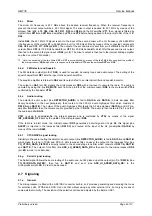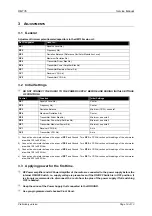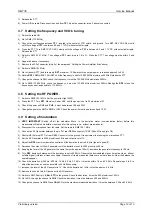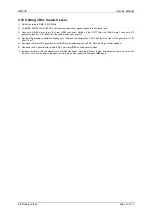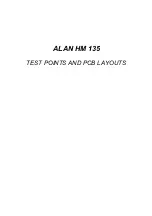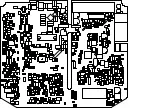
HM135
Service Manual
Preliminary version
Page 5 of 13
2.3 Front panel (head) circuitry
The microprocessor
DD800
runs off a 8 MHz oscillator which is composed of
X800
, and
R829
.
DD800
is basically
used to control the LCD unit
XT80
, to decode the commands coming from the front keypad
S801
to
S808
) as well
as to switch the front LEDs
DA800
. It is also used to light up the LCD backlight (
VD800
to
VD805
) as well as for
the PTT circuit as over stated.
The negative voltage necessary for the LCD is created by a charge pump which consists of
VT815
,
VT813
,
VT812
,
VD809
and
VD808
. The output (line
–8V
) is fed to the regulator
DA804:A
which outputs the line
VD
in
order to supply the LCD unit.
The hang-up functions work this way: the line
AUX_HOOK
is connected to the microphone’s hook and it’s
normally grounded (microphone hooked). When the mike is removed from its hook, the line
AUX_HOOK
changes
its state driving the transistor
VT809
. This changes the status of the pin
21
of the microprocessor
DD800
which
opens the monitor through a command sent to the main microprocessor
DD5
through a serial command.
2.4 VCO / Synthesizer (PLL)
This section basically consists of the Temperature-Compensated Crystal Oscillator (TCXO), Voltage Controlled
Oscillators (VCOs), Synthesizer and the Loop Filter.
2.4.a
Temperature-Compensated Crystal Oscillator (TCXO)
The reference oscillator is composed by the temperature compensated crystal X2 and related circuitry (DA1:A.
VD19
,
VD20
,
VT21
and
VT20
),
RP2
is used to adjust the oscillator on frequency (12.8 MHz) at room temperature.
The reference oscillator is held within the specifications
±
5 ppm from -25 to +55
℃
.
2.4.b Voltage-Controlled
Oscillators
The receive VCO consists of
VT11
,
CV1
,
VD6
and
VD9
. This VCO oscillates at 45.1 MHz above the programmed
receive frequency (i.e. from 181.1 to 219.1 MHz for the 135-174 MHz range). The VCO’s oscillating frequency is
tuned by the varactors
VD6
and
VD9
.
The transmitter VCO consists of
VT17
,
CV2
,
VD11
-
VD12
and
VD13
-
VD14
and oscillates directly to the TX carrier
frequency range (i.e. from 135 to 174 MHz range). The TX VCO is directly frequency-modulated by means of the
varactor
VD15
which is driven by the modulating signal (line
A
) regulated by the trimmer
RP4
. This is part of the
double-point modulation and works mainly in high AF modulating frequencies), the other part of the double point-
modulation is explained in the par. “Transmitter Audio Circuits”.
The tuning voltage for the VCOs is supplied from the output of the Loop Filter made with
R73
,
R74
,
R78
,
C99
,
C100
and
C101
.
Only one of the VCOs runs at a time. In RX the line
RXC
(which is obtained from the
+8V_RX
line coming from
the voltage switch
VT41
) is high enabling the RX VCO via the transistor
VT16
. During this time the line
TXC
(which is obtained from the
+8VTX
line coming from the voltage switch
VT42
) is low, so the TX VCO is disabled.
When the PTT is pressed, the
RXC
line becomes low switching the RX VCO off. At the same time the line
TXC
goes high activating the TX VCO via the transistor
VT18
.
The output of the VCOs are AC coupled (
C91
and
C109
) and sent to the synthesizer buffer
VT19
, then sent to
DA5
for an additional buffering. The output of
DA5
is connected to the low-pass filter (
L27
,
L28
,
L29
and related
capacitors), then directly sent to the TX stages (line
HET_TX
which
is sent to the pre-driver amplifier
VT24
) or RX
stages (line
HET_RX
which is sent to
the RX mixer
A1
) due to the RF switching action provided by
VD16
and
VD17
which are controlled by the lines
+8VRX
and
8V_TX_F
respectively (this last line is obtained from the line
+8VTX passed through the filter created with
L52
,
L53
and related capacitors). The output from the VCO
necessary to feedback the PLL IC
DA3
(i.e. line
PLL_RF
send to pin
8
) is directly output from
VT19
and fed
through
R106
,
C362
and
C134
. , whilst the other part of the signal is fed to
DA5
, then passed through the low-
pass filter (
L27
,
L28
,
L29
,
C130
,
C132
,
C133
and
C131
). Diodes
VD16
and
VD17
act as signal switches in order
to feed the signal to RX or TX stages at the appropriate time according to the switching voltages which are,
respectively, the lines
+8VRX
and
8V_TX_F
.
The PLL IC
DA3
receives the reference signal from the TCXO (pin
1
) and the feedback from the VCO (pin
8
). The
synthesizer is tuned in 5.00 KHz or 6.25 KHz steps. The output from the PLL IC (pin
15
and
16
) is used to drive
the PLL charge pump which consists of
VT12
,
VT13
,
VT14
and
VT15
, then the charge pumps sent the output to
the PLL filter in order to close the loop.
Summary of Contents for HM135
Page 14: ...ALAN HM 135 TEST POINTS AND PCB LAYOUTS...
Page 16: ...p d f M a c h i n e b y B r o a d G u n S o f t w a r e...
Page 17: ...p d f M a c h i n e b y B r o a d G u n S o f t w a r e...
Page 18: ...p d f M a c h i n e b y B r o a d G u n S o f t w a r e...
Page 19: ...p d f M a c h i n e b y B r o a d G u n S o f t w a r e...
Page 20: ...p d f M a c h i n e b y B r o a d G u n S o f t w a r e...
Page 21: ...p d f M a c h i n e b y B r o a d G u n S o f t w a r e...
Page 22: ...p d f M a c h i n e b y B r o a d G u n S o f t w a r e...
Page 23: ...p d f M a c h i n e b y B r o a d G u n S o f t w a r e...
Page 24: ...p d f M a c h i n e b y B r o a d G u n S o f t w a r e...
Page 25: ...p d f M a c h i n e b y B r o a d G u n S o f t w a r e...
Page 26: ...ALAN HM 135 ELECTRICAL DIAGRAMS...
Page 27: ...HM135_HEAD_FEB_14_2004 SCH p d f M a c h i n e b y B r o a d G u n S o f t w a r e...
Page 28: ...12 13 14 D 5 6 7 B 10 8 9 C p d f M a c h i n e b y B r o a d G u n S o f t w a r e...
Page 32: ...p d f M a c h i n e b y B r o a d G u n S o f t w a r e...
Page 33: ...1 2 3 4 8 A p d f M a c h i n e b y B r o a d G u n S o f t w a r e...
Page 34: ...5 6 7 B p d f M a c h i n e b y B r o a d G u n S o f t w a r e...
Page 35: ...5 6 7 B 10 8 9 C 1 2 3 A 12 13 14 D p d f M a c h i n e b y B r o a d G u n S o f t w a r e...
Page 36: ...p d f M a c h i n e b y B r o a d G u n S o f t w a r e...
Page 37: ...ALAN HM 135 EXPLODED VIEW AND PART LIST...
Page 38: ...ALAN HM 135 PROGRAMMING MANUAL...








